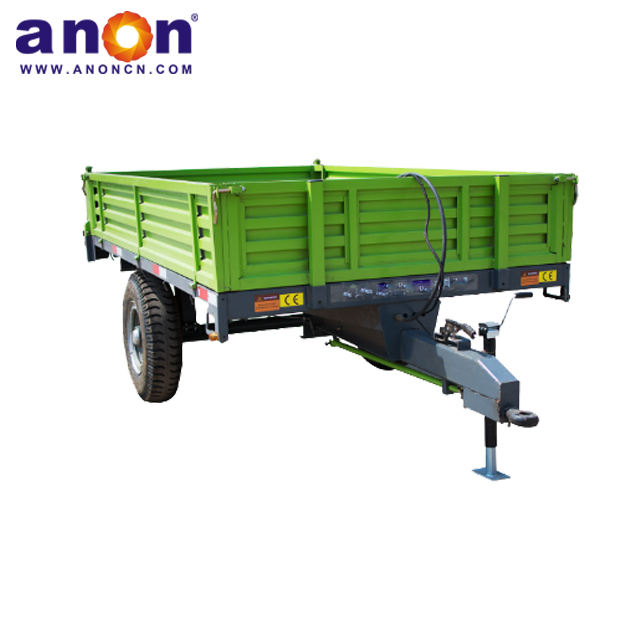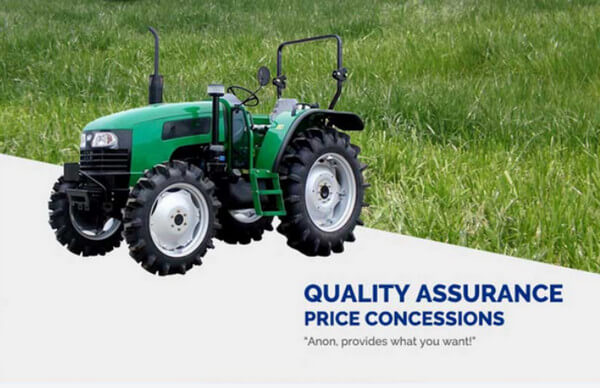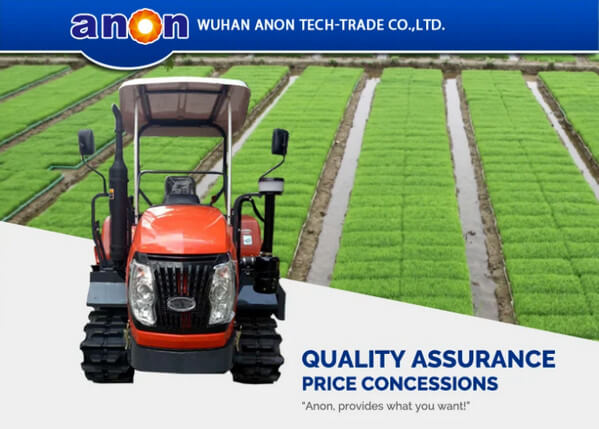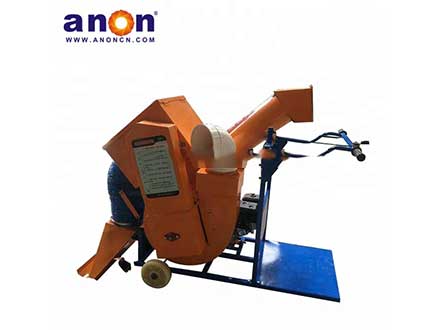Introduction
When you need a reliable and efficient solution to transport your goods, consider using a trailer with your tractor. It can help you get more out of your tractor while reducing your operating costs. In this article, I’ll share some helpful information to help you choose the right trailer.

tractor trailer
What is a Tractor Trailer?
A tractor-trailer is a transport device without a power source, so it needs a tractor to pull it. It’s commonly used to load and transport goods. Tractor-trailers can be customized based on your transport needs, and the hitch can be easily connected and disconnected. This flexibility allows the trailer to be used with different tractors, making it very convenient and efficient.
Key differences from highway tractor-trailers
Agricultural tractor-trailers are specially designed for farming operations. Farmers use them for field transport, pulling implements, moving crops short distances, and delivering farm supplies. They usually carry loads between 2 to 10 tons, with some heavy-duty models reaching up to 15 tons. Their main purpose is to handle rough terrain and perform well at low speeds with high torque.
In contrast, highway trailers are built for road freight transport. They handle long-distance and mid-range logistics, including container shipping, bulk goods, and equipment. These trailers carry much heavier loads—full trailers often range from 30 to 50 tons, and semi-trailers can reach 40 to 60 tons. Highway trailers focus on high-speed stability, load efficiency, and legal compliance for road use.
Using a tractor-trailer with a tractor allows you to transport goods more efficiently, like delivering them faster and reducing your workload. It plays an important role in agricultural production.
Essential Components of a Tractor-Trailer
An agricultural tractor-trailer mainly consists of two parts: the tractor and the trailer. These two components work together to complete various farm tasks.
Tractor
The tractor provides the power and pulls various types of farm trailers for field operations. Modern tractors are usually equipped with high-horsepower engines, four-wheel drive systems, and strong transmissions to handle rough terrain and heavy loads. In addition, tractors can supply hydraulic and electrical connections to trailers, supporting extra functions like tipping, lighting, and more.
Trailer
Farm trailers vary in design, size, and structure depending on their intended use. Common materials include reinforced steel plates and aluminum alloy, which provide strength while reducing overall weight. Some trailers are fully enclosed, making them ideal for transporting grain and feed. Others feature semi-enclosed or open designs, suitable for carrying straw, tools, or livestock.
Axle
The axle is a crucial part of a tractor-trailer. It supports the weight of the cargo and transfers the pulling force from the tractor to the trailer. Choosing the right axle is very important for the stability of your tractor-trailer.
Suspension System
During transport, the tractor-trailer relies on the suspension system to reduce shocks and keep the trailer balanced. The suspension system helps increase the upward force on the wheels, reducing sliding between the wheels and the road, and improving the trailer’s pulling power.
Baking System
A tractor-trailer is equipped with a powerful braking system to ensure your safe and efficient operation. Even when you are transporting heavy loads, the braking system responds quickly and is very reliable.
Types of Tractor-Trailer

Number of Axles
The axle is an important part of a tractor-trailer, and its number affects the trailer’s performance. Tractor-trailers can be classified into single-axle and double-axle trailers based on the number of axles.
Single-axle tractor-trailer
A single-axle tractor-trailer has only one axle. The structure is relatively simple, lightweight, and flexible, making it suitable for transporting light and small items. Its load capacity is average, and its stability is lower. If you need to work on flat terrain and transport light goods, a single-axle tractor-trailer should be sufficient.
Double-axle tractor-trailer
A double-axle tractor-trailer has two axles. Its structure is a bit more complex, but it offers better load capacity and stability, making it suitable for transporting heavier goods. The two axles help distribute the load more evenly, improving stability and safety. If you need to work on rough or complex terrain, a double-axle tractor-trailer is a better choice for you.
Braking Method
Tractor-trailers can be classified by their braking systems into mechanical braking and air braking. Air braking is further divided into air-inflated braking and air-out braking.
Mechanical Braking
Mechanical brakes rely on mechanical parts to achieve braking, using friction to slow down or stop the trailer’s movement. Mechanical brakes have a simple structure with fewer parts, making them easy to maintain and replace at a lower cost. However, their braking performance is relatively average. If your tractor-trailer is small or carrying light loads, mechanical brakes will meet basic braking needs.
Air Braking
Air brakes use compressed air as the braking medium. They work by converting air pressure into braking force. The difference between air-out brakes and air-in brakes is in their power sources.
Air brakes have a more complex structure but offer strong braking power, quick response, and high safety. If you need to brake frequently or if your tractor-trailer is large and carries heavy loads, air brakes provide more reliable and efficient braking performance.
Unloading Method
Tractor-trailers can be classified into tipping trailers and non-tipping trailers based on how they unload.
Non-tipping Trailer
Non-tipping trailers rely on external equipment or manual labor for unloading, such as cranes, forklifts, or hand transport. This method is less efficient, especially for heavy or large loads. If you need to unload various types of goods that vary in size, have low unloading frequency, or are in a complex unloading environment, a non-tipping trailer is better for you.
Tipping Trailer
Automatic unloading can save a lot of time and labor. Based on the unloading direction, tipping trailers can be classified into side dump, rear dump, and three-way dump tractor trailers.
Side Dumping
Side dump trailers have the feature of tilting and opening the side of the trailer, allowing materials to be unloaded directly from the side. They are useful in narrow work areas where rear dumping is not possible. Be sure to choose a stable and solid surface for side dumping to avoid the risk of the trailer tipping over.
Rear Dumping
Rear dump trailers have a design where the back of the trailer tilts and opens, allowing materials to be unloaded from the rear. This design is adaptable, has a small turning radius, and can unload cargo at even intervals. However, it requires a relatively spacious work area.
Three-way Tipping Trailer
Three-way dump trailers usually have a more complex hydraulic system that allows for multi-directional unloading, such as tilting to the left, right, or rear. This design offers greater flexibility and can meet various unloading needs. If your work area is complex and requires unloading from multiple directions, a three-way dump trailer is the best choice for you.
Usage of Tractor-Trailer

Tractor-trailers have a wide range of uses, with the most common being transportation. Some tractor-trailers even have the capability to spread fertilizers. In addition to agriculture, tractor-trailers can also assist with transportation tasks in industries such as construction, manufacturing, and mining.
Transporting Harvested Crops
Farm trailers are ideal for transporting crops like corn, wheat, and rice. They efficiently carry harvested crops from the field to storage facilities, drying machines, or designated locations, saving significant time and labor.
Safe Transport of Livestock
Trailers equipped with fences or specialized compartments can safely transport livestock such as cattle, sheep, and pigs, reducing the risk of injury during transport and improving transfer efficiency.
Transporting Feed, Fertilizer, Tools, and Supplies
Farm trailers can also be used for daily transportation of feed, fertilizers, pesticides, water containers, tools, and other supplies. With their versatility, they meet the varying needs of different stages of farm operations.
Supporting Daily Logistics Across the Farm
Whether it’s short-distance transport between fields or the coordination of materials between warehouses, machinery sheds, and livestock areas, trailers are a reliable tool for improving logistics efficiency on the farm.
Reduced Manual Labor
Trailers can significantly reduce the need for manual handling and multiple transports, saving time and labor and increasing productivity.
Benefits of Tractor-Trailer

Diverse structures
Tractor-trailers can be customized based on your needs to fit different transport tasks.
Flexibility
The design of tractor-trailers allows them to be flexible during transport. They can handle different terrains and environments, so even if the road conditions are tough, they can still help you complete the transport tasks effectively.
Increase transport efficiency
Tractor-trailers can significantly improve efficiency in agriculture and transport, reducing labor costs. This is especially noticeable when your farm is large.
Easy to operate
Connecting a tractor-trailer to a tractor is simple, and driving it doesn’t require much technical skill.
Saves Time and Labor
Farm trailers can transport large quantities of crops, supplies, and tools in a single trip, greatly reducing the need for multiple runs. This is especially valuable during busy harvest seasons, as it helps save labor, lower physical strain, and improve overall efficiency.
Increases Harvest Efficiency
During the harvest season, farm trailers can be used in conjunction with harvesters, allowing for continuous loading and transport without stopping the machine. This prevents delays caused by frequent unloading, significantly boosting harvest efficiency.
Reduces Equipment Wear
Using trailers for transportation reduces the need for tractors or harvesters to make frequent trips across the field. This effectively lightens the mechanical load, extends the equipment’s lifespan, and minimizes soil compaction damage to the farmland.
One Vehicle, Multiple Uses
By simply swapping out trailers for different functions, a single tractor can handle various tasks such as transportation, dump unloading, and feed distribution. This maximizes the efficiency of the equipment and enhances the level of agricultural mechanization.
Maintenance and Safety Tips
Regular tire and brake checks
Tires are crucial components for the trailer’s load-bearing and mobility. They should be regularly checked for tire pressure, wear, and any cracks. The brake system should also be routinely tested for sensitivity to ensure reliable braking when transporting heavy loads or during downhill operations.
Hitch inspection and lubrication
The trailer hitching device must be securely fastened. It should be regularly checked for any looseness or wear and lubricated with oil to ensure smooth operation, preventing jamming and excessive wear.
Load balancing and security
When loading crops, supplies, or livestock, it is important to ensure load balance to avoid uneven or overloaded conditions. Use tie-down straps, barriers, or other securing devices to firmly fasten the cargo, preventing slipping or tipping during transport and ensuring safe travel.
Cleaning
After use, it is important to promptly clean the trailer of dirt, crop residue, or chemical residues, especially when transporting edible crops or feed. Failing to clean the trailer regularly can lead to mold, contamination, or rusting of metal parts, which can reduce the trailer’s lifespan and compromise crop safety.
Proper Storage
When not in use for an extended period, you should store your trailer in a covered area to protect it from the elements and the elements.
Choosing your Right Tractor-Trailer

Consider farm size and crops
Firstly, if you have a small family farm, a lightweight, multifunctional trailer is suitable. For large-scale farms, heavy-duty, multi-axle trailers designed for professional transport are more appropriate. Different crops have varying requirements for trailer capacity, protective structures, and unloading methods.
Consider your land and tractor
Secondly, consider the terrain, capacity, and compatibility with your tractor. Hilly terrain requires trailers with higher chassis and better stability, while flat land allows for larger flatbed or dump trailers. The trailer’s size, hitching system, and braking system must be compatible with your existing tractor model to ensure safe and efficient operation.
Consider budget
Finally, consider your budget. When choosing a trailer, balance functionality with cost and plan your budget accordingly. Compare different manufacturers to choose the most cost-effective machine.
Consider maintenance requirements
First, choose a trailer with a sturdy structure and high-quality materials to ensure long-term use. Secondly, consider maintenance requirements. A trailer that is easy to maintain and has readily available parts can save you a lot of trouble with subsequent maintenance.
Wrap Up
I’ve talked a lot about basic information about tractor-trailers. With so many types of trailers available, you should choose based on your needs and the specifications of your tractor. If you need help selecting a tractor-trailer, feel free to contact us at ANON. We will provide you with the best service and the most suitable trailer for your needs.
FAQ
What is the warranty coverage for a tractor-trailer?
Within one year of purchase, the entire tractor-trailer is covered by a warranty. If you have any issues during this period, you can contact us, and we will send a professional repair technician to help if needed.







